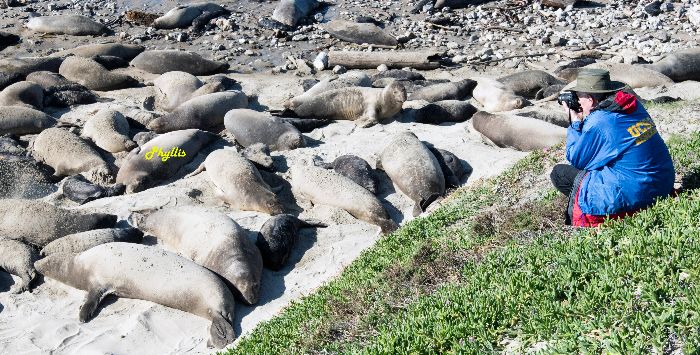Campus News
The mighty Phyllis returns after record-shattering swim
The tagged elephant seal’s landing at Año Nuevo means she swam about 7,400 miles, longer than any elephant seal recorded over two decades—then she gave birth to a baby boy.




It was a tense two weeks for researchers at the Dan Costa Lab at UC Santa Cruz.
On New Year’s Eve, a satellite tag on a 1,200-pound female elephant seal named Phyllis fell silent.
Phyllis—named after the late Phyllis Sooy, a go-getter philanthropist from South Carolina—had set a record for swimming past the International Date Line and almost to Japan on her eight-month foraging journey. Then, 683 miles from home on her return trip to Año Nuevo, Phyllis stopped transmitting her location.
About 15 percent of tagged elephant seals die or are eaten by predators on their annual feeding adventure, according to UC Santa Cruz Ph.D. student Rachel Holser.
Researchers’ hearts sank.
But on Jan. 14, an observer spotted Phyllis resting in a rocky cove at Año Nuevo State Park. Five days later, Phyllis gave birth to a healthy-looking baby boy.
Phyllis’s landing meant the eight-year-old seal had swum about 7,400 miles, longer than any elephant seal recorded over two decades. The average female elephant seal logs just over 4,000 miles on feeding trips.
Once the data is recovered from Phyllis’s satellite tag (which turned out to have a dead battery), the actual miles she covered may be closer to 10,000, Holser noted, since these animals seldom swim in a straight line and spend lots of time diving to find food.
“Phyllis,” said UC Santa Cruz Professor of Ecology and Evolutionary Biology Dan Costa, “turned out to be an amazing seal.”
What’s also interesting is that, besides Phyllis, three other tagged female elephant seals also outdid their more average sisterhood during the most current foraging trip.
Claudia, Mary, and Sheila all recorded swims that took them past the International Date Line. In addition, Sheila embarked on a journey that is somewhat unusual for a female elephant seal. Instead of heading into the Pacific, where the majority of female elephant seals go, Sheila went toward the Aleutian Islands, where male elephant seals typically travel—and then proceeded to swim farther west than any of them.
“Her data,” said Holser, “is pretty cool.”
Now the question for UC Santa Cruz researchers is: Why did 4 of the 20 tagged seals swim unusually far this year?
It’s a question that UC Santa Cruz is in a unique place to ask and to answer, according to Costa.
Usually, animal studies last only about three or four years, but UC Santa Cruz has been tracking elephant seals for about two decades and has compiled what is arguably the largest marine mammal diving and tracking record on the planet.
Because of the breadth of its information, “we can now say those four animals did something unusual,” Costa said, “but is that a new normal or is this just an extreme year?”
Over the next months, researchers will be analyzing data, including ocean temperature, salinity, and depth measurements that some of the seals’ tracking devices recorded, in hopes of discovering whether the animals’ long swims were an anomaly or were in response to climate change.
Or perhaps, there was something in the four seals’ personalities that made them long-distance champions. In fact, seal personality is also one of the topics currently being studied at UC Santa Cruz—a research project undertaken by Holser, who, coincidentally, was the recipient of grant from a $200,000 graduate fellowship endowment Phyllis Sooy’s widower, Steve Sooy, had established earlier.
For Steve Sooy, it was an emotional moment when he accompanied Holser and Costa on a trip to observe Phyllis and her new pup.
His late wife, Sooy said, was one of those people who not only loved the couple’s annual long trips across country to visit family and allow Steve to work as a docent at Año Nuevo State Park, but she also had a lead foot when it came to her own driving.
“I really can’t describe exactly what I felt,” Steve said of seeing Phyllis the seal for the first time. “But there was a completeness of saying, ‘Hey kid, you did a good job.’”
“It was,” he said, his voice breaking slightly, “a sweet moment.”